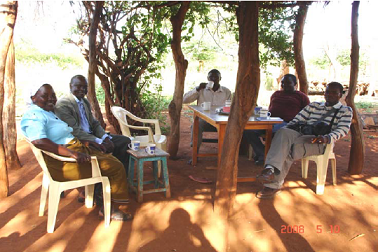Livelihoods Under Climate Variability and Change: An Analysis of the Adaptive Capacity of Rural Poor to Water Scarcity in Kenya’s Drylands (ACCCA)


Summary
In dryland communities droughts are a significant cause of decreased crop production and herd size to less than the minimum required for subsistence. Dryland communities, however, have gained experience in trying to adapt to climatic changes. For instance, examples of water harvesting techniques in the drylands of west and east Africa appear to be effective and can potentially serve as lessons for other communities. However further research into the relationships between water harvesting, vulnerability reduction, adaptive capacity, poverty reduction and possibilities for the duplication of these initiatives need to be undertaken.
This project will contribute to strengthening the capacities of dryland communities in Kenya to cope with climate variability, improve food production and sustain people’s livelihoods. Using a case study approach, the project will provide an overview of the typology of adaptation measures that have been undertaken, examine their implications on livelihoods, identify the drivers of effective rain water harvesting as an adaptation strategy to frequent droughts, and build capacity for climate vulnerability assessments and decision-making at various stakeholder levels (household, community, private sector and government).
Methodology
The following tools were used to form this project’s methodology:
- In-depth review of primary literature on the impacts of climate change on pastoral and agro-pastoral livelihoods in the dry lands of Sub-Sahara Africa, with particular focus on Kenya.
- Conducting case studies to identify and review coping mechanisms including successful water harvesting initiatives among target communities
- Conducting case studies on selected households practising water harvesting and determining the relationship to reducing poverty and hunger.
- Data mining: Collecting and collating all available information from the case studies – their economic and ecological environments and indigenous knowledge on climate change.
- Evaluation of the factors behind the effectiveness of successful water harvesting techniques / methods in the local environment:
- Analyzing the social assets (human, social and political capital), and material assets (physical, financial and natural capital) to provide information and contribute to knowledge for formulating and supporting policy decisions for dry land livelihoods support.
- Capturing community indigenous knowledge on climate change.
- Construction of family portraits of selected families practicing water harvesting.
- Development of site-specific guidelines and information tools on adaptation to climate change and suitable water harvesting techniques for use by farmers, extension agents and development specialists.
Adaptation Options
The local communities acknowledged the need to conserve water and 55% expressed need for a water reservoir, and growing of draught resistant crops, sinking bore holes and water recycling All the respondents were in agreement on the need to take up measures individually and collectively to address the problem of water shortage with all of them indicating that re-aforestation should be the first priority. Over 89% of respondents felt that the burning of charcoal should be outlawed to conserve the forests and 73% expressed the need to construct dams to harvest the runoff and use this water during the dry spell.
Key Messages
The effects of climate change are already being experienced by the farmers and especially those in dry lands and other fragile ecosystems and there is need to upscale the technologies of rain water harvesting to alleviate the water scarcity problem. Since most of the farmers are resource poor, there is need for injection of capital to help the farmers construct reservoirs for rain water harvesting. Training is needed to equip the farmers with other inexpensive, locally tested ways of run-off harvesting which is already in use by some of the farmers. Re-afforestation programmes are needed and drought tolerant tree seedlings made available to the farmers.
(0) Comments
There is no content